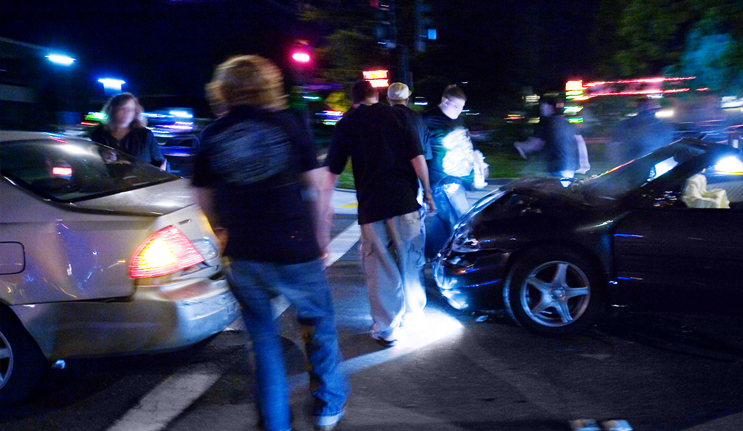It’s sometimes difficult to differentiate truths from myths. We tend to believe what we think is true. It’s normal. When it comes to driving, following distance is one of those myths that drivers seem to be a little confused about. Many drivers believe it’s measured by car lengths, but in reality, it’s measured in seconds. Measuring following distance by seconds gives us time to see brake lights illuminate directly in front of us, time to move our foot from the gas pedal over to the brake pedal, and time to stop the vehicle safely.
When drivers follow closely behind your vehicle, they are not giving themselves enough time to respond to your brake lights. Tailgaters also reduce their field of view ahead of your vehicle as your vehicle tends to block their vision. This makes it difficult to observe the brake lights of vehicles several car lengths up the road—making it virtually impossible to anticipate changing traffic conditions ahead. So, what can you do to avoid getting rear-ended if you need to stop quickly and you are being tailgated?
The first step is to anticipate and always be planning an escape. Waiting until you’re stopped, and seeing a vehicle approaching too quickly from behind you, then trying to figure out where you can go if you need to avoid a rear-end crash may be too late. To avoid a rear-end crash, consider using the lane next to you, a parking lot, or even moving up a sidewalk. However, planning an escape well in advance is definitely not the same as using the escape route. Now that you know where you can go to avoid a rear-end crash, you now must determine how to go about doing this safely and with enough time to make it work successfully.
Regular mirror checks are an important first step. Once you notice a vehicle is following you too closely, you may want to begin checking your mirrors a little more often to continuously assess the situation. Always evaluating your surroundings to recognize situations when there’s an increased risk for a rear-end crash is a major step toward being mentally ready for successfully performing an evasive maneuver. Once you know a vehicle is tailgating you, you recognize that braking hard at the last minute will create a dangerous situation for you and the driver directly behind you. Give yourself an extra second or two of following distance so if the driver in front of you brakes quickly, you’ll have more time to stop. The extra space in front of you allows you to brake more gradually, thus the driver behind receives more notice, reducing the risk of a rear-end crash.
Another scenario that increases the risk for rear-end collisions is stopped traffic, especially at intersections. Intersections account for most collisions across North America and rear-end crashes represent a significant portion of these events. In fact, rear-end crashes are the most commonly reported collision in North America. Consequently, it’s well worth learning how to avoid them.
One of the most common mistakes drivers make before being involved in a rear-end crash at a red light is not leaving adequate space in front of their vehicle. Many drivers may see a vehicle approaching quickly from behind but can’t escape their lane because there’s not enough space ahead. Although this may seem unusual, leaving more than a vehicle’s length of space in front of your vehicle while you’re stopped (with no vehicle stopped behind you) provides you room to move out of the way if an emergency develops. If road conditions are slippery because of rain, snow or ice, leaving more than one vehicle’s length ahead of you is a wise choice.
As you’re slowing down for stopped traffic or a red light, leaving extra space in front of your vehicle, you’ll have to quickly search for possible escape paths. Again, the lane next to you, up onto the sidewalk or on the shoulder, or a parking lot may work. Sometimes simply moving forward into the extra space in front of you is enough to permit the vehicle behind you to stop in time without colliding with your vehicle.
While stopped it’s important to keep monitoring your mirrors every few seconds while glancing ahead to see when the traffic light has changed or when the vehicles ahead of you are starting to move again. It’s completely unnecessary to wait until you hear screeching tires before realizing you’re at risk of a rear-end crash.
While you’re stopped, if you notice a vehicle approaching from behind you a little too fast, begin slowly creeping forward as they close in on your vehicle with your foot still touching the brake pedal, if possible. Since most drivers tend to slow down as they close in on brake lights, moving your vehicle forward very slowly with your brake lights still activated, you will provide the approaching driver additional space to stop safely. This technique is also effective during wet road conditions. This is the benefit of planning ahead and giving yourself extra space in front of your vehicle.
Stay Safe on the Road with these eLearning Courses:
However, if you feel the vehicle behind is approaching too quickly to stop in time, even with you moving up slightly, head toward your escape path. Assuming they will stop in time could be a dangerous error. Moving out of the way while your vehicle is in motion can be performed more quickly compared to moving out of the way from a stopped position. Your forward motion can give you a head start.
Despite what you may have heard previously, avoiding a rear-end crash is 100% doable. But you must plan for it in advance, sometimes even before you spot the early warning signs. And remember, learning how to set up and use an escape path to avoid a rear-end crash just might save your life.
About the Author

Scott Marshall has spent over 30 years promoting road safety. He has been a road safety journalist since 2005. Scott was also an on-air judge on the Discovery Network’s Canada’s Worst Driver during its first three seasons. Scott welcomes any questions or comments you may have at safedriver36@yahoo.ca.
Stay safe on the road with these online training courses:
Smartphones and Smarter Driving (Micro Course)
Seat Belt Safety (Micro Course)
Defensive Driving – Small Vehicles



